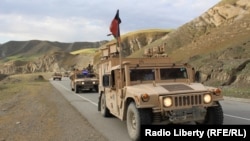The mountainous province of Badakhshan in northeastern Afghanistan evaded Taliban rule when the hard-line Islamist movement dominated the rest of the country in the 1990s.
Today, however, the Taliban control large swathes of rural Badakhshan. Their growing influence there is now prompting concerns that the province will become a bastion for regional terrorism because it borders Pakistan, China, and Tajikistan.
Abdul Wahab Majruh is among thousands of locals who fled their homes in Badakhshan’s remote northeastern Warduj district two years ago after it was captured by the Taliban and allied foreign fighters.
The 38-year-old schoolteacher, his wife, and their five children joined thousands of residents of Warduj and neighboring Yumgan districts to escape Taliban rule and seek shelter in the nearby district of Baharak. Insurgents have imposed harsh rules in the two districts in the name of implementing the Islamic Shari’a law.
“This is the third year that all of our schools [in Warduj] are closed by the insurgents, which forced more than 300 of our teachers to serve in other districts,” Majruh told RFE/RL’s Gandhara website. “The militants collect one-tenth of wheat crops, walnuts, and other produce in the name of collecting an Islamic tax, Usher. They also frequently force villagers to feed them.”
Mohammad Dawlat Khawar, the district governor of Warduj, now operates in Baharak. He says the closure of all 17 schools in Warduj is depriving some 11,000 students, including 5,000 girls, of an education. Thousands among the region’s estimated 35,000 residents have left Warduj to evade Taliban rule, he maintains.
He says the insurgents have recreated a mini version of the Taliban emirate from the 1990s.
“After capturing the region, they first collected all television sets to enforce a ban on watching it, and they banned women from going to the local bazaar without a male guardian,” Khawar said. “They have established roll calls at the mosques to know if any men are missing prayers.”
Similar to the Taliban’s feared religious police, he says, an insurgent mullah now “whips and beats” locals if he deems them to be to committing a “vice.”
He says the presence of foreign fighters complicates the situation in Warduj. “We are concerned that an estimated 200 foreign fighters are active. They include citizens of Uzbekistan, members of the Uighur Muslim minority from China, and citizens of Tajikistan,” he said.
Warduj is located close to the Wakhan Corridor, a narrow strip of Afghan territory that extends to the Chinese border and prevents Pakistan and Tajikistan from sharing a land border. The region could be of interest to members of the East Turkistan Islamic Movement (ETIM).
The organization has been loosely allied with factions of the Afghan and Pakistani Taliban during the past two decades and was declared a terrorist group by the United States and China.
Afghan officials see the ETIM’s predominantly Uighur members as keen on infiltrating their neighboring homeland – Xinjiang region in northwestern China.
Gul Mohammad Baidar, the deputy provincial governor of Badakhshan, says foreign fighters including Uighurs are among the foreign militants active in Warduj, Yumgan, and parts of Jurm and Raghistan districts.
“Most foreign fighter obey a man by the name of Mawlawi Furqan. The number of Uighurs is now over 50, but they are aiming high,” he said. “They want to increase their number and then move into China through the Wakhan Corridor.”
Baidar says the Afghan government is committed to not allowing ETIM members to enter Xinjiang. “We are vigorously fighting against them,” he said.
Baidar says foreign militants infiltrated Badakhshan from neighboring Pakistan.
"When Pakistan launched an operation in North Waziristan [in 2014], the fighters poured into Keran-u-Menjan and from there to Khustak mainly through [the northwestern district of] Chitral in Pakistan,” he noted. “We also border the restive province of Nuristan, which in turn borders Kunar Province [to the east].”
In a press release on February 8, the U.S. forces in Afghanistan said they had bombed Taliban and ETIM hideouts in Badakhshan.
“U.S. strikes in Badakhshan Province destroyed Taliban training camps and other fighting positions. These training camps support terrorist operations inside Afghanistan as well as operations conducted by [the] ETIM in the border region with China and Tajikistan,” the statement said. “The U.S. strikes support Afghanistan in reassuring its neighbors that it is not a safe sanctuary for terrorists who want to carry out cross-border operations.”
The statement added that ETIM militants “pose a threat to China and enjoy support from the Taliban in Badakhshan and throughout the border region.”
In Beijing, Chinese Foreign Ministry spokesman Geng Shuang said they have no specific information about the issue.
He, however, said that fighting the ETIM was a "core counterterrorism concern" for Beijing. "Striking against terrorism is the responsibility of all countries in the world," he was quoted as saying by Reuters.
The Taliban have not commented on the situation in Badakhshan. It was not possible to independently verify the claims of warring sides in a remote Afghan frontline.
Lawmaker Mohammad Zakaria Sawda represents Badakhshan in the Afghan parliament. He says the militants are trying to turn Badakhshan into a stepping stone for proxy wars in the region.
But, he adds, no one is set to benefit from turmoil in Badakhshan.
“Everyone -- factions and countries engaged in supporting terrorism --must know that the terrorists will eventually turn their guns against their sponsors,” he said.







